A Guide to Public Green Space Planning for Urban Ecosystem Services
Abstract
1. Introduction
2. Methods
2.1. Study Area
2.2. Public Green Space Mapping and Urban ES Quantification
2.3. Urban ES Supply Rates
2.4. Resident Surveys
2.5. Delphi Method
3. Results
3.1. Public Green Space Inventory
3.2. Resident Surveys—Urban ES Priorities
3.3. Delphi Analysis
4. Integration of Stakeholder Priorities with Quantitative Urban ES Estimates
4.1. Planning Considerations
4.1.1. What Urban ES are Available from the Landscape?
4.1.2. What Land Cover Types Thrive in This Location?
4.1.3. What are the Urban ES Priorities of Multiple Stakeholder Groups?
4.1.4. Which Urban ES can be Quantified According to Land Cover Type?
4.1.5. What Barriers or Constraints Exist?
4.2. Alternative Planting Regimes
5. Discussion
5.1. Public Green Space Inventory
5.2. Stakeholder Priorities
5.2.1. Resident Priorities
5.2.2. Delphi Analysis
5.2.3. Resident and Delphi Comparison
“What drives public agencies such as our Public Works Department is regulatory requirements—meeting the Federal Clean Water Act and our NPDES Permit requirements (e.g., reducing pollution into local waterways, reducing flooding, and improving air quality). Other items are secondary to the basic welfare and safety of the general public.”
5.3. Integration of Stakeholder Priorities with Potential for Local Benefit
6. Conclusions
Supplementary Materials
Author Contributions
Funding
Acknowledgments
Conflicts of Interest
References
- Grimm, N.B.; Faeth, S.H.; Golubiewski, N.E.; Redman, C.L.; Wu, J.; Bai, X.; Briggs, J.M. Global change and the ecology of cities. Science 2008, 319, 756–760. [Google Scholar] [CrossRef] [PubMed]
- Luederitz, C.; Brink, E.; Gralla, F.; Hermelingmeier, V.; Meyer, M.; Niven, L.; Panzer, L.; Partelow, S.; Rau, A.-L.; Sasaki, R.; et al. A review of urban ecosystem services: Six key challenges for future research. Ecosyst. Serv. 2015, 14, 98–112. [Google Scholar] [CrossRef]
- Gómez-Baggethun, E.; Gren, Å.; Barton, D.N.; Langemeyer, J.; McPhearson, T.; O’Farrell, P.; Andersson, E.; Hamstead, Z.; Kremer, P. Urban Ecosystem Services. In Urbanization, Biodiversity and Ecosystem Services: Challenges and Opportunities; Springer: Dordrecht, The Netherlands, 2013; pp. 175–251. ISBN 978-94-007-7087-4. [Google Scholar]
- Millennium Ecosystem Assessment. Ecosystems and Human Well-Being; Island Press: Washington, DC, USA, 2005. [Google Scholar]
- United Nations. World Urbanization Prospects: The 2005 Revision; United Nations: New York, NY, USA, 2006. [Google Scholar]
- United Nations. World Urbanization Prospects: The 2014 Revision, Highlights; Department of Economic and Social Affairs: New York, NY, USA, 2014. [Google Scholar]
- Demuzere, M.; Orru, K.; Heidrich, O.; Olazabal, E.; Geneletti, D.; Orru, H.; Bhave, A.G.; Mittal, N.; Feliu, E.; Faehnle, M. Mitigating and adapting to climate change: Multi-functional and multi-scale assessment of green urban infrastructure. J. Environ. Manag. 2014, 146, 107–115. [Google Scholar] [CrossRef] [PubMed]
- Nowak, D.J.; Hirabayashi, S.; Bodine, A.; Greenfield, E. Tree and forest effects on air quality and human health in the United States. Environ. Pollut. 2014, 193, 119–129. [Google Scholar] [CrossRef] [PubMed]
- Nowak, D.J.; Dwyer, J.F. Understanding the Benefits and Costs of Urban Forest Ecosystems. In Urban and Community Forestry in the Northeast; Springer: Amsterdam, The Netherlands, 2007; pp. 25–46. ISBN 978-1-4020-4288-1. [Google Scholar]
- Nowak, D.J.; Greenfield, E.J.; Hoehn, R.E.; Lapoint, E. Carbon storage and sequestration by trees in urban and community areas of the United States. Environ. Pollut. 2013, 178, 229–236. [Google Scholar] [CrossRef]
- Xiao, Q.; McPherson, E.G. Rainfall interception by Santa Monica’s municipal urban forest. Urban Ecosyst. 2002, 6, 291–302. [Google Scholar] [CrossRef]
- Akbari, H.; Pomerantz, M.; Taha, H. Cool surfaces and shade trees to reduce energy use and improve air quality in urban areas. Sol. Energy 2001, 70, 295–310. [Google Scholar] [CrossRef]
- Jim, C.Y.; Chen, W.Y. Recreation–amenity use and contingent valuation of urban greenspaces in Guangzhou, China. Landsc. Urban Plan. 2006, 75, 81–96. [Google Scholar] [CrossRef]
- Derkzen, M.L.; van Teeffelen, A.J.A.; Verburg, P.H. Quantifying urban ecosystem services based on high-resolution data of urban green space: An assessment for Rotterdam, the Netherlands. J. Appl. Ecol. 2015, 52, 1020–1032. [Google Scholar] [CrossRef]
- Mexia, T.; Vieira, J.; Principe, A.; Anjos, A.; Silva, P.; Lopes, N.; Freitas, C.; Santos-Reis, M.; Correia, O.; Branquinho, C.; et al. Ecosystem services: Urban parks under a magnifying glass. Environ. Res. 2018, 160, 469–478. [Google Scholar] [CrossRef]
- Haase, D.; Larondelle, N.; Andersson, E.; Artmann, M.; Borgstrom, S.; Breuste, J.; Gomez-Baggethun, E.; Gren, A.; Hamstead, Z.; Hansen, R.; et al. A quantitative review of urban ecosystem service assessments: Concepts, models, and implementation. Ambio 2014, 43, 413–433. [Google Scholar] [CrossRef] [PubMed]
- Paulin, M.J.; Remme, R.P.; van der Hoek, D.C.J.; de Knegt, B.; Koopman, K.R.; Breure, A.M.; Rutgers, M.; de Nijs, T. Towards nationally harmonized mapping and quantification of ecosystem services. Sci. Total Environ. 2020, 703, 134973. [Google Scholar] [CrossRef] [PubMed]
- Elmqvist, T.; Setälä, H.; Handel, S.; van der Ploeg, S.; Aronson, J.; Blignaut, J.; Gómez-Baggethun, E.; Nowak, D.; Kronenberg, J.; de Groot, R. Benefits of restoring ecosystem services in urban areas. Curr. Opin. Environ. Sustain. 2015, 14, 101–108. [Google Scholar] [CrossRef]
- Jim, C.Y.; Chen, W.Y. Assessing the ecosystem service of air pollutant removal by urban trees in Guangzhou (China). J. Environ. Manag. 2008, 88, 665–676. [Google Scholar] [CrossRef] [PubMed]
- Tratalos, J.; Fuller, R.A.; Warren, P.H.; Davies, R.G.; Gaston, K.J. Urban form, biodiversity potential and ecosystem services. Landsc. Urban Plan. 2007, 83, 308–317. [Google Scholar] [CrossRef]
- Goldenberg, R.; Kalantari, Z.; Cvetkovic, V.; Mortberg, U.; Deal, B.; Destouni, G. Distinction, quantification and mapping of potential and realized supply-demand of flow-dependent ecosystem services. Sci. Total Environ. 2017, 593–594, 599–609. [Google Scholar] [CrossRef] [PubMed]
- Wang, Y.; Akbari, H. The effects of street tree planting on Urban Heat Island mitigation in Montreal. Sustain. Cities Soc. 2016, 27, 122–128. [Google Scholar] [CrossRef]
- Nowak, D.J.; Stevens, J.C.; Sisinni, S.M.; Luley, C.J. Effects of Urban Tree Management and Species Selection on Atmospheric Carbon Dioxide. J. Arboric. 2002, 28, 113–122. [Google Scholar]
- Townsend-Small, A.; Czimczik, C.I. Carbon sequestration and greenhouse gas emissions in urban turf. Geophys. Res. Lett. 2010, 37. [Google Scholar] [CrossRef]
- Ignatieva, M.; Ahrné, K.; Wissman, J.; Eriksson, T.; Tidåker, P.; Hedblom, M.; Kätterer, T.; Marstorp, H.; Berg, P.; Eriksson, T.; et al. Lawn as a cultural and ecological phenomenon: A conceptual framework for transdisciplinary research. Urban For. Urban Green. 2015, 14, 383–387. [Google Scholar] [CrossRef]
- Milesi, C.; Running, S.W.; Elvidge, C.D.; Dietz, J.B.; Tuttle, B.T.; Nemani, R.R. Mapping and modeling the biogeochemical cycling of turf grasses in the United States. Environ. Manag. 2005, 36, 426–438. [Google Scholar] [CrossRef] [PubMed]
- United States Department of Agriculture. 2018 Irrigation and Water Management Survey; 2017 Census of Agriculture; US Department of Agriculture: Washington, DC, USA, 2019.
- United States Department of Agriculture. Land Use and Land Cover Estimates for the United States. Available online: https://www.ers.usda.gov/about-ers/partnerships/strengthening-statistics-through-the-icars/land-use-and-land-cover-estimates-for-the-united-states/#d (accessed on 27 May 2020).
- Robbins, P.; Birkenholtz, T. Turfgrass revolution: Measuring the expansion of the American lawn. Land Use Policy 2003, 20, 181–194. [Google Scholar] [CrossRef]
- Qian, Y.; Follett, R.F.; Kimble, J.M. Soil Organic Carbon Input from Urban Turfgrasses. Soil Sci. Soc. Am. J. 2010, 74. [Google Scholar] [CrossRef]
- Lerman, S.B.; Contosta, A.R. Lawn mowing frequency and its effects on biogenic and anthropogenic carbon dioxide emissions. Landsc. Urban Plan. 2019, 182, 114–123. [Google Scholar] [CrossRef]
- Monteiro, J.A. Ecosystem services from turfgrass landscapes. Urban For. Urban Green. 2017, 26, 151–157. [Google Scholar] [CrossRef]
- Nowak, D.J.; Heisler, G.M. Air Quality Effects of Urban Trees and Parks; National Recreation and Park Association: Ashburn, VA, USA, 2010. [Google Scholar]
- Matthews, T.; Lo, A.Y.; Byrne, J.A. Reconceptualizing green infrastructure for climate change adaptation: Barriers to adoption and drivers for uptake by spatial planners. Landsc. Urban Plan. 2015, 138, 155–163. [Google Scholar] [CrossRef]
- De Groot, R.S.; Fisher, B.; Christie, M.; Aronson, J.; Braat, L.; Gowdy, J.; Haines-Young, R.; Maltby, E.; Neuville, A.; Polasky, S.; et al. Integrating the Ecological and Economic Dimensions in Biodiversity and Ecosystem Service Valuation. In The Economics of Ecosystems and Biodiversity: Ecological and Economic Foundations; Kumar, P., Ed.; Routledge: Abingdon-on-Thames, UK, 2010; pp. 9–40. [Google Scholar]
- Menzel, S.; Teng, J. Ecosystem services as a stakeholder-driven concept for conservation science. Conserv. Biol. 2010, 24, 907–909. [Google Scholar] [CrossRef]
- TEEB. TEEB Manual for Cities—Ecosystem Services in Urban Management; TEEB: Geneva, Switzerland, 2011. [Google Scholar]
- Castro, A.J.; Martín-López, B.; García-Llorente, M.; Aguilera, P.A.; López, E.; Cabello, J. Social preferences regarding the delivery of ecosystem services in a semiarid Mediterranean region. J. Arid Environ. 2011, 75, 1201–1208. [Google Scholar] [CrossRef]
- Castro, A.J.; Verburg, P.H.; Martín-López, B.; Garcia-Llorente, M.; Cabello, J.; Vaughn, C.C.; López, E. Ecosystem service trade-offs from supply to social demand: A landscape-scale spatial analysis. Landsc. Urban Plan. 2014, 132, 102–110. [Google Scholar] [CrossRef]
- Derkzen, M.L.; van Teeffelen, A.J.A.; Verburg, P.H. Green infrastructure for urban climate adaptation: How do residents’ views on climate impacts and green infrastructure shape adaptation preferences? Landsc. Urban Plan. 2017, 157, 106–130. [Google Scholar] [CrossRef]
- Madureira, H.; Nunes, F.; Oliveira, J.V.; Cormier, L.; Madureira, T. Urban residents’ beliefs concerning green space benefits in four cities in France and Portugal. Urban For. Urban Green. 2015, 14, 56–64. [Google Scholar] [CrossRef]
- Tyrväinen, L.; Mäkinen, K.; Schipperijn, J. Tools for mapping social values of urban woodlands and other green areas. Landsc. Urban Plan. 2007, 79, 5–19. [Google Scholar] [CrossRef]
- Young, R.F. Managing municipal green space for ecosystem services. Urban For. Urban Green. 2010, 9, 313–321. [Google Scholar] [CrossRef]
- Müller, F.; De Groot, R.; Willemen, L. Ecosystem Services at the Landscape Scale: The Need for Integrative Approaches. LO 2010, 23, 1–11. [Google Scholar] [CrossRef]
- US Census Bureau. Oregon: 2010 Population and Housing Unit Counts; U.S. Department of Commerce: Washington, DC, USA, 2012.
- American Lung Association. State of the Air 2019; American Lung Association: Chicago, IL, USA, 2019. [Google Scholar]
- Benninghoff, B. NPDES Municipal Separate Storm Sewer System Permit: Evaluation and Fact Sheet; Oregon Department of Environmental Quality: Portland, OR, USA, 2010.
- City of Eugene. Picture. Plan. Play. A Vision and Implementation Plan for Eugene’s Parks and Recreation System; City of Eugene: Eugene, OR, USA, 2018.
- Diebel, J.; Norda, J.; Kretchmer, O. Overview of Friendly Area, Eugene, Oregon. Available online: https://statisticalatlas.com/neighborhood/Oregon/Eugene/Friendly-Area/Overview (accessed on 8 January 2019).
- U.S. Census Bureau. U.S. Census Bureau QuickFacts. Available online: https://www.census.gov/quickfacts/fact/table/US/PST045219 (accessed on 14 August 2020).
- The Trust for Public Land ParkScore index: The most comprehensive evaluation of park access and quality in the 100 largest U.S. cities. Available online: https://www.tpl.org/parkscore (accessed on 13 October 2020).
- Davies, Z.G.; Edmondson, J.L.; Heinemeyer, A.; Leake, J.R.; Gaston, K.J. Mapping an urban ecosystem service: Quantifying above-ground carbon storage at a city-wide scale. J. Appl. Ecol. 2011, 48, 1125–1134. [Google Scholar] [CrossRef]
- Zulian, G.; Liekens, I.; Broekx, S.; Kabisch, N.; Kopperoinen, L.; Geneletti, D. Mapping Urban Ecosystem Services. In Mapping Ecosystem Services; Burkhard, B., Maes, J., Eds.; Pensoft Publishers: Sofia, Bulgaria, 2017; pp. 312–318. [Google Scholar]
- ESRI. ArcMap 10.7; Environmental Systems Research Institute: Redlands, CA, USA, 2019. [Google Scholar]
- Senanayake, I.P.; Welivitiya, W.D.D.P.; Nadeeka, P.M. Urban green spaces analysis for development planning in Colombo, Sri Lanka, utilizing THEOS satellite imagery—A remote sensing and GIS approach. Urban For. Urban Green. 2013, 12, 307–314. [Google Scholar] [CrossRef]
- Oregon Department of Geology and Mineral Industries. OLC Middle Fork Willamette River 2015 Lidar Project Lidar QC Report; Oregon Department of Geology and Mineral Industries: Portland, OR, USA, 2017.
- Geneletti, D.; Cortinovis, C.; Zardo, L.; Esmail, B.A. Planning for Ecosystem Services in Cities; SpringerBriefs in Environmental Science; Springer International Publishing: Cham, Switzerland, 2020; ISBN 978-3-030-20023-7. [Google Scholar]
- City of Eugene. Stormwater Management Manual; City of Eugene: Eugene, OR, USA, 2014.
- ESRI. ArcGIS Pro 2.6; Environmental Systems Research Institute: Redlands, CA, USA, 2020. [Google Scholar]
- Cariñanos, P.; Calaza-Martínez, P.; O’Brien, L.; Calfapietra, C. The Cost of Greening: Disservices of Urban Trees. In The Urban Forest; Pearlmutter, D., Calfapietra, C., Samson, R., O’Brien, L., Krajter Ostoić, S., Sanesi, G., Alonso del Amo, R., Eds.; Future City; Springer International Publishing: Cham, Switzerland, 2017; Volume 7, pp. 79–87. ISBN 978-3-319-50279-3. [Google Scholar]
- Escobedo, F.J.; Kroeger, T.; Wagner, J.E. Urban forests and pollution mitigation: Analyzing ecosystem services and disservices. Environ. Pollut. 2011, 159, 2078–2087. [Google Scholar] [CrossRef]
- Juanita, A.-D.; Ignacio, P.; Jorgelina, G.-A.; Cecilia, A.-S.; Carlos, M.; Francisco, N. Assessing the effects of past and future land cover changes in ecosystem services, disservices and biodiversity: A case study in Barranquilla Metropolitan Area (BMA), Colombia. Ecosyst. Serv. 2019, 37, 100915. [Google Scholar] [CrossRef]
- Loewenthal, K. An Introduction to Psychological Tests and Scales; Taylor & Francis Inc.: New York, NY, USA, 2001; Volume 42. [Google Scholar]
- R Core Team. R: A Language and Environment for Statistical Computing; R Foundation for Statistical Computing: Vienna, Austria, 2019. [Google Scholar]
- Dalkey, N.C. The Delphi Method: An Experimental Study of Group Opinion; The RAND Corporation: Santa Monica, CA, USA, 1969. [Google Scholar]
- Thrall, G.I.; McCartney, J.W. Keeping the Gardbage Out: Using Delphi Method for GIS Criteria. Geogr. Inf. Syst. 1991, 1, 46–52. [Google Scholar]
- Loughlin, K.G.; Moore, L.F. Using Delphi to achieve congruent objectives and activities in a pediatrics department. Acad. Med. 1979, 54, 101–106. [Google Scholar] [CrossRef]
- Putnam, J.W.; Spiegel, A.N.; Bruininks, R.H. Future Directions in Education and Inclusion of Students with Disabilities: A Delphi Investigation. Except. Child. 2016, 61, 553–576. [Google Scholar] [CrossRef]
- Stewart, J.; O’Halloran, C.; Harrigan, P.; Spencer, J.A.; Barton, J.R.; Singleton, S.J. Identifying appropriate tasks for the preregistration year: Modified Delphi technique. BMJ 1999, 319, 224–229. [Google Scholar] [CrossRef] [PubMed]
- Von der Gracht, H.A. Consensus measurement in Delphi studies. Technol. Forecast. Soc. Chang. 2012, 79, 1525–1536. [Google Scholar] [CrossRef]
- City of Eugene. Eugene Charter; City of Eugene: Eugene, OR, USA, 2002.
- City of Ashland. City Charter; City of Ashland: Ashland, OR, USA, 2007.
- De Groot, R.S.; Wilson, M.A.; Boumans, R.M.J. A typology for the classification, description and valuation of ecosystem functions, goods and services. Ecol. Econ. 2002, 41, 393–408. [Google Scholar] [CrossRef]
- Bidegain, I.; Cerda, C.; Catalán, E.; Tironi, A.; López-Santiago, C. Social preferences for ecosystem services in a biodiversity hotspot in South America. PLoS ONE 2019, 14, e0215715. [Google Scholar] [CrossRef]
- Schmidt, K.; Walz, A.; Martín-López, B.; Sachse, R. Testing socio-cultural valuation methods of ecosystem services to explain land use preferences. Ecosyst. Serv. 2017, 26, 270–288. [Google Scholar] [CrossRef]
- Stålhammar, S.; Pedersen, E. Recreational cultural ecosystem services: How do people describe the value? Ecosyst. Serv. 2017, 26, 1–9. [Google Scholar] [CrossRef]
- Costanza, R.; d’Arge, R.; de Groot, R.; Farber, S.; Grasso, M.; Hannon, B.; Limburg, K.; Naeem, S.; O’Neill, R.V.; Paruelo, J.; et al. The value of the world’s ecosystem services and natural capital. Nature 1997, 387, 253–260. [Google Scholar] [CrossRef]
- Hardelin, J.; Lankoski, J. Land use and ecosystem services; OECD Food, Agriculture and Fisheries Papers; OECD Publishing: Paris, France, 2018; Volume 114. [Google Scholar]
- Hasan, S.; Shi, W.; Zhu, X. Impact of land use land cover changes on ecosystem service value—A case study of Guangdong, Hong Kong, and Macao in South China. PLoS ONE 2020, 15, e0231259. [Google Scholar] [CrossRef]
- Kreuter, U.P.; Harris, H.G.; Matlock, M.D.; Lacey, R.E. Change in ecosystem service values in the San Antonio area, Texas. Ecol. Econ. 2001, 39, 333–346. [Google Scholar] [CrossRef]
- Lopes, L.F.G.; dos Santos Bento, J.M.R.; Arede Correia Cristovão, A.F.; Baptista, F.O. Exploring the effect of land use on ecosystem services: The distributive issues. Land Use Policy 2015, 45, 141–149. [Google Scholar] [CrossRef][Green Version]
- Martínez-Harms, M.J.; Balvanera, P. Methods for mapping ecosystem service supply: A review. Int. J. Biodivers. Sci. Ecosyst. Serv. Manag. 2012, 8, 17–25. [Google Scholar] [CrossRef]
- Zardo, L.; Geneletti, D.; Pérez-Soba, M.; Van Eupen, M. Estimating the cooling capacity of green infrastructures to support urban planning. Ecosyst. Serv. 2017, 26, 225–235. [Google Scholar] [CrossRef]
- Lee-Mäder, E.; Fowler, J.; Vento, J.; Hopwood, J. 100 Plants to Feed the Bees: Provide a Healthy Habitat to Help Pollinators Thrive; Storey Publishing: North Adams, MA, USA, 2016; ISBN 978-1-61212-701-9. [Google Scholar]
- Attracting Native Pollinators: Protecting North America’s Bees and Butterflies: The Xerces Society Guide; Lee-Mäder, E., Xerces Society, Eds.; Storey Pub: North Adams, MA, USA, 2011; ISBN 978-1-60342-695-4. [Google Scholar]
- City of Eugene. Council Resolution No. 5240: A Resolution Designating Eugene as a Bee City USA Affiliate; City of Eugene: Eugene, OR, USA, 2018.
- Adamson, N.L.; Borders, B.; Cruz, J.K.; Jordan, S.F.; Gill, K.; Hopwood, J.; Lee-Mäder, E.; Minnerath, A.; Vaughan, M. Pollinator Plants: Maritime Northwest Region; The Xerces Society: Portland, OR, USA, 2017. [Google Scholar]
- Metro. Native plants for Willamette Valley yards booklet. Available online: https://www.oregonmetro.gov/native-plants-willamette-valley-yards-booklet (accessed on 15 May 2020).
- Biernacka, M.; Kronenberg, J. Classification of institutional barriers affecting the availability, accessibility and attractiveness of urban green spaces. Urban For. Urban Green. 2018, 36, 22–33. [Google Scholar] [CrossRef]
- City of Eugene. Parks and Recreation System Needs Assessment Report; City of Eugene: Eugene, OR, USA, 2016.
- City of Eugene. Water Resource Conservation Maps. Available online: https://www.eugene-or.gov/808/Water-Resource-Conservation-Maps (accessed on 4 August 2020).
- Romem, I. Can U.S. Cities Compensate for Curbing Sprawl by Growing Denser? Buildzoom: San Francisco, CA, USA, 2016. [Google Scholar]
- Hedblom, M.; Lindberg, F.; Vogel, E.; Wissman, J.; Ahrné, K. Estimating urban lawn cover in space and time: Case studies in three Swedish cities. Urban Ecosyst. 2017, 20, 1109–1119. [Google Scholar] [CrossRef]
- Casalegno, S.; Anderson, K.; Hancock, S.; Gaston, K.J. Improving models of urban greenspace: From vegetation surface cover to volumetric survey, using waveform laser scanning. Methods Ecol. Evol. 2017, 8, 1443–1452. [Google Scholar] [CrossRef]
- Parent, J.R.; Volin, J.C.; Civco, D.L. A fully-automated approach to land cover mapping with airborne LiDAR and high resolution multispectral imagery in a forested suburban landscape. ISPRS J. Photogramm. Remote Sens. 2015, 104, 18–29. [Google Scholar] [CrossRef]
- Faehnle, M.; Bäcklund, P.; Tyrväinen, L. Looking for the role of nature experiences in planning and decision making: A perspective from the Helsinki Metropolitan Area. Sustain. Sci. Pract. Policy 2011, 7, 45–55. [Google Scholar] [CrossRef]
- Camps-Calvet, M.; Langemeyer, J.; Calvet-Mir, L.; Gómez-Baggethun, E. Ecosystem services provided by urban gardens in Barcelona, Spain: Insights for policy and planning. Environ. Sci. Policy 2016, 62, 14–23. [Google Scholar] [CrossRef]
- Earth Economics. Nature’s Value; An Economic View of Eugene’s Parks, Natural Areas and Urban Forest; City of Eugene: Eugene, OR, USA, 2014.
- City of Eugene. Eugene Parks & Recreation Ballot Measures 2018; City of Eugene: Eugene, OR, USA, 2018.
- Larson, K.L.; Nelson, K.C.; Samples, S.R.; Hall, S.J.; Bettez, N.; Cavender-Bares, J.; Groffman, P.M.; Grove, M.; Heffernan, J.B.; Hobbie, S.E.; et al. Ecosystem services in managing residential landscapes: Priorities, value dimensions, and cross-regional patterns. Urban Ecosyst. 2015, 19, 95–113. [Google Scholar] [CrossRef]
- Jim, C.Y.; Chen, W.Y. Perception and Attitude of Residents Toward Urban Green Spaces in Guangzhou (China). Environ. Manag. 2006, 38, 338–349. [Google Scholar] [CrossRef] [PubMed]
- City of Eugene. Community Gardens: Gardener’s Manual. Available online: https://www.eugene-or.gov/DocumentCenter/View/31611/Community-Gardens-Spring-2017-Manual?bidId= (accessed on 14 August 2020).
- City of Eugene Friendly Area Neighbors. Available online: https://www.eugene-or.gov/1374/Friendly-Area-Neighbors (accessed on 21 May 2020).
- Wang, S.; He, Q.; Ai, H.; Wang, Z.; Zhang, Q. Pollutant concentrations and pollution loads in stormwater runoff from different land uses in Chongqing. J. Environ. Sci. 2013, 25, 502–510. [Google Scholar] [CrossRef]
- Richards, L. Protecting Water Resources with Higher-Density Development; Environmental Protection Agency: Washington, DC, USA, 2006.
- Ignatieva, M.; Eriksson, F.; Eriksson, T.; Berg, P.; Hedblom, M. The lawn as a social and cultural phenomenon in Sweden. Urban For. Urban Green. 2017, 21, 213–223. [Google Scholar] [CrossRef]
- Pienaar, E.F.; Soto, J.R.; Lai, J.H.; Adams, D.C. Would County Residents Vote for an Increase in Their Taxes to Conserve Native Habitat and Ecosystem Services? Funding Conservation in Palm Beach County, Florida. Ecol. Econ. 2019, 159, 24–34. [Google Scholar] [CrossRef]
- Tian, Y.; Wu, H.; Zhang, G.; Wang, L.; Zheng, D.; Li, S. Perceptions of ecosystem services, disservices and willingness-to-pay for urban green space conservation. J. Environ. Manag. 2020, 260, 110140. [Google Scholar] [CrossRef]
- Gatto, P.; Vidale, E.; Secco, L.; Pettenella, D. Exploring the willingness to pay for forest ecosystem services by residents of the Veneto Region. Bio-Based Appl. Econ. 2013, 21–43. [Google Scholar] [CrossRef]
- Sato, M.; Ushimaru, A.; Minamoto, T. Effect of different personal histories on valuation for forest ecosystem services in urban areas: A case study of Mt. Rokko, Kobe, Japan. Urban For. Urban Green. 2017, 28, 110–117. [Google Scholar] [CrossRef]
- McNally, C.G.; Gold, A.J.; Pollnac, R.B.; Kiwango, H.R. Stakeholder perceptions of ecosystem services of the Wami River and Estuary. ES 2016, 21, art34. [Google Scholar] [CrossRef]
- Zoderer, B.M.; Tasser, E.; Carver, S.; Tappeiner, U. Stakeholder perspectives on ecosystem service supply and ecosystem service demand bundles. Ecosyst. Serv. 2019, 37, 100938. [Google Scholar] [CrossRef]
- Larson, L.R.; Jennings, V.; Cloutier, S.A. Public Parks and Wellbeing in Urban Areas of the United States. PLoS ONE 2016, 11, e0153211. [Google Scholar] [CrossRef]
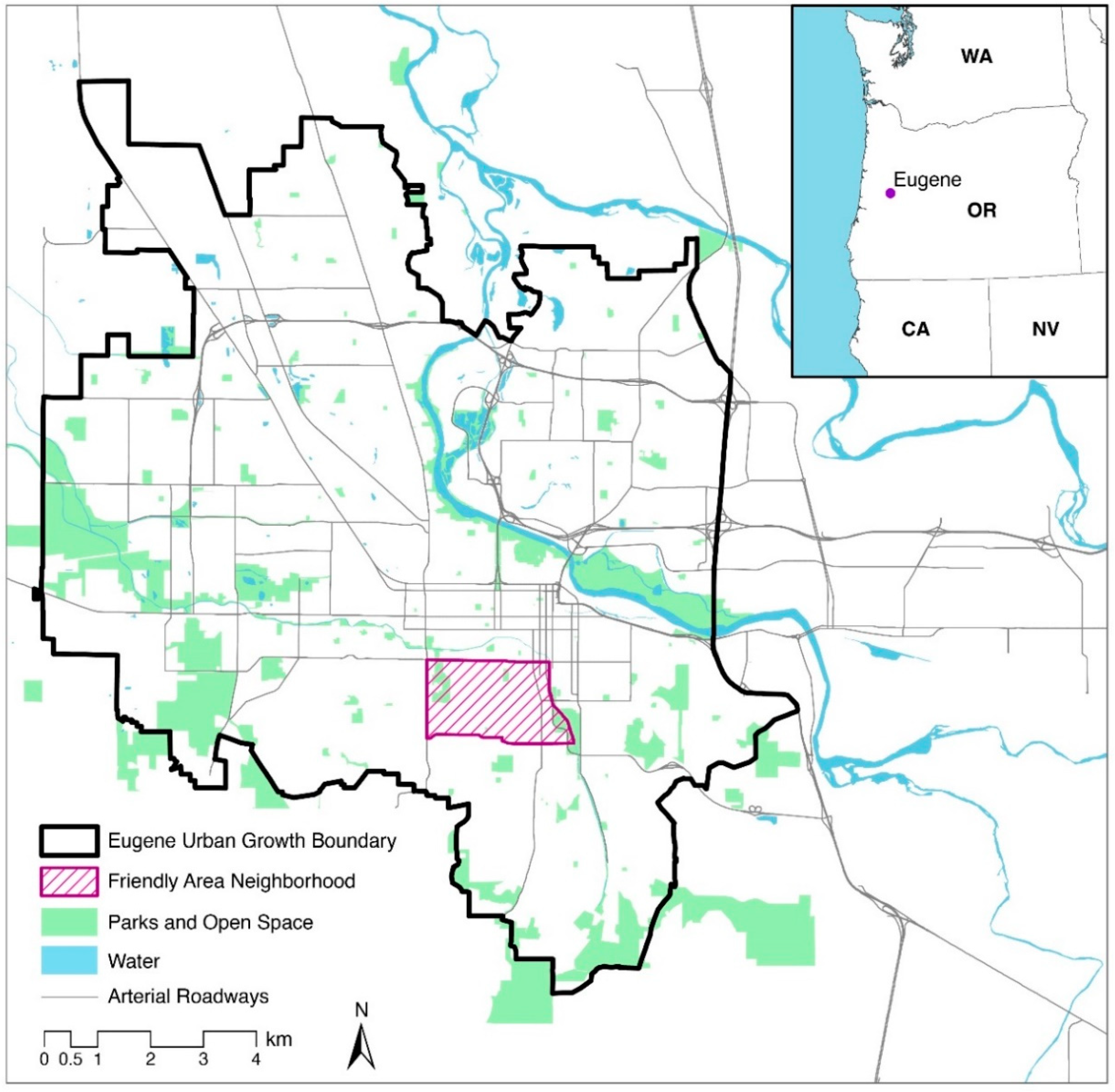
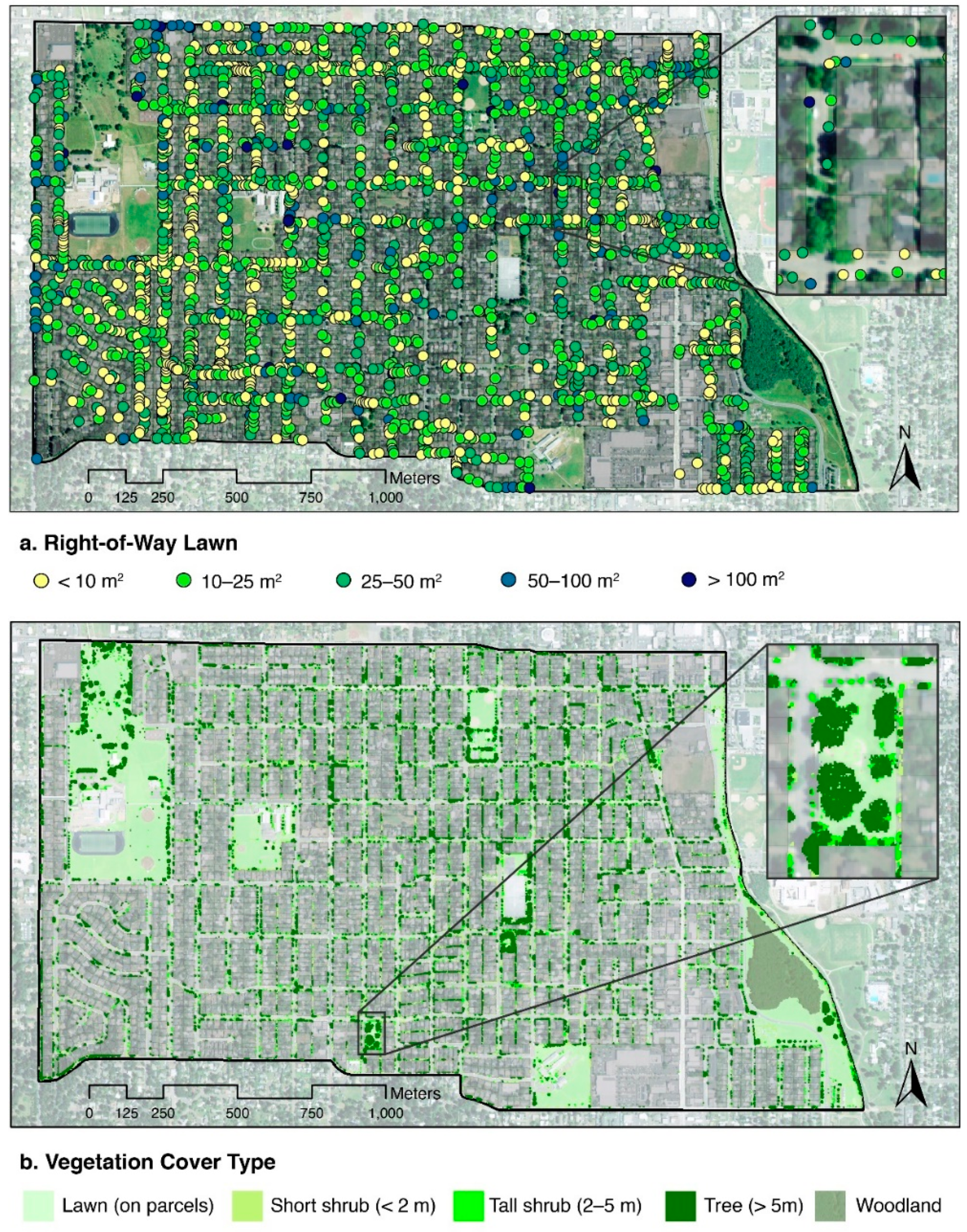

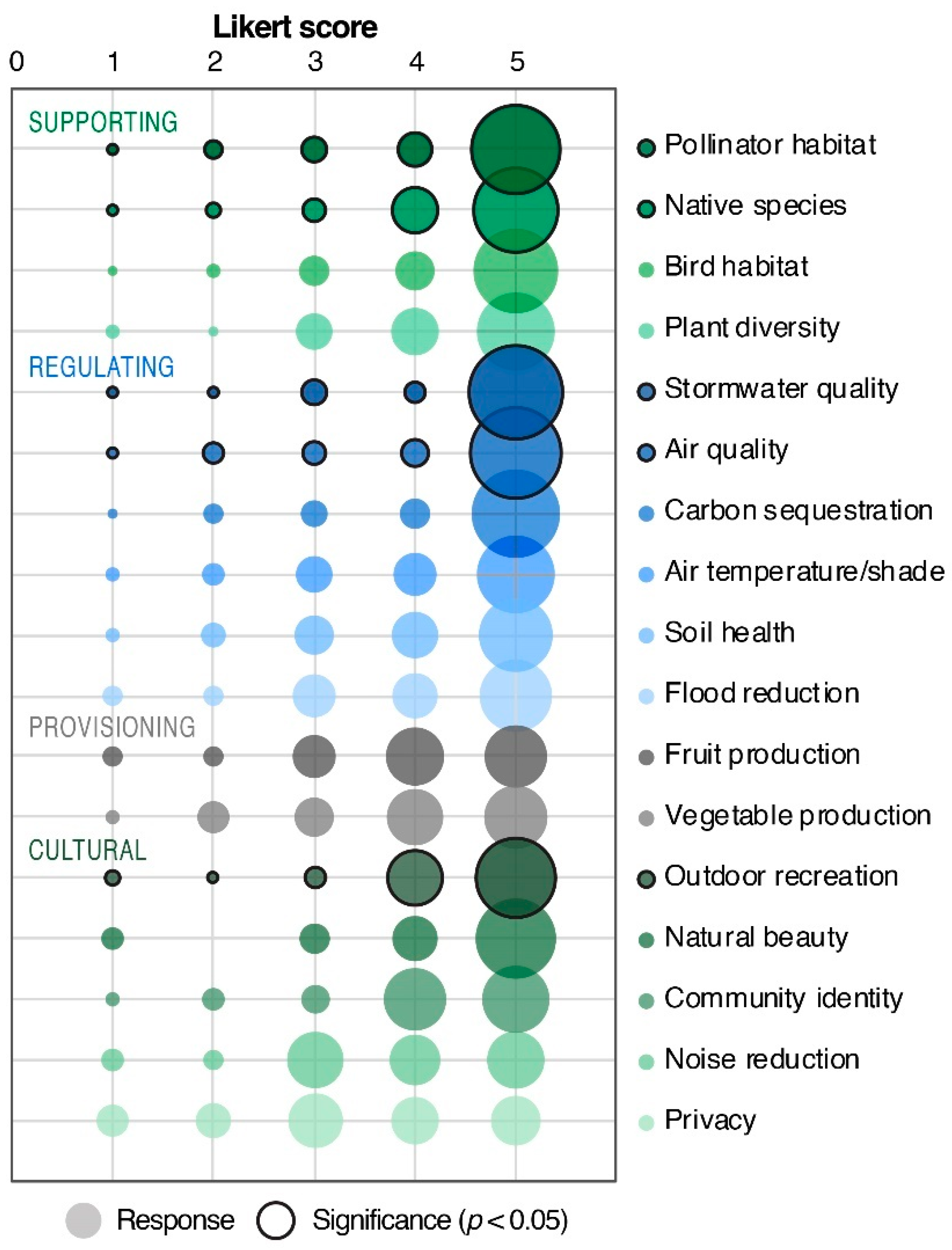
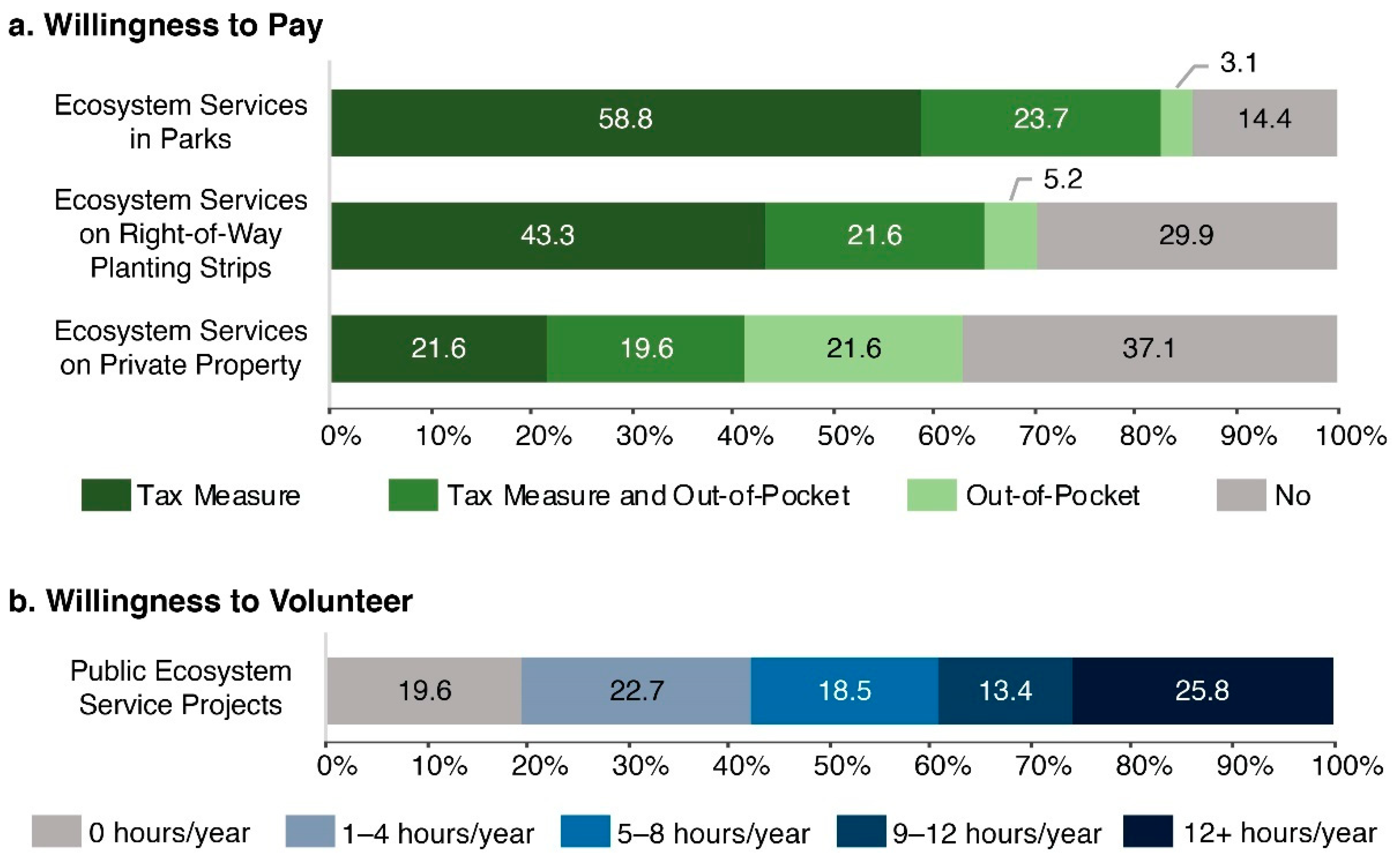
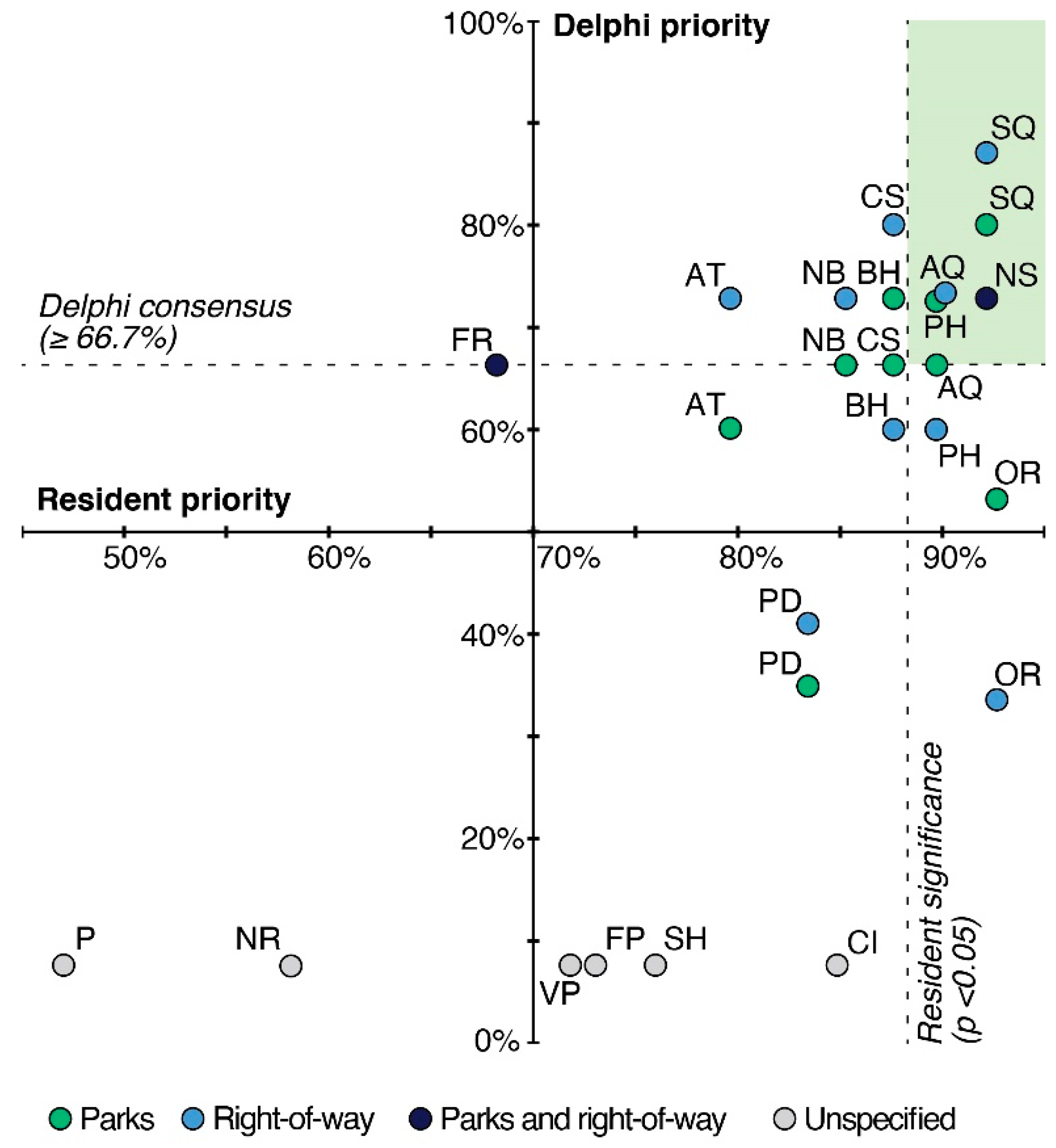
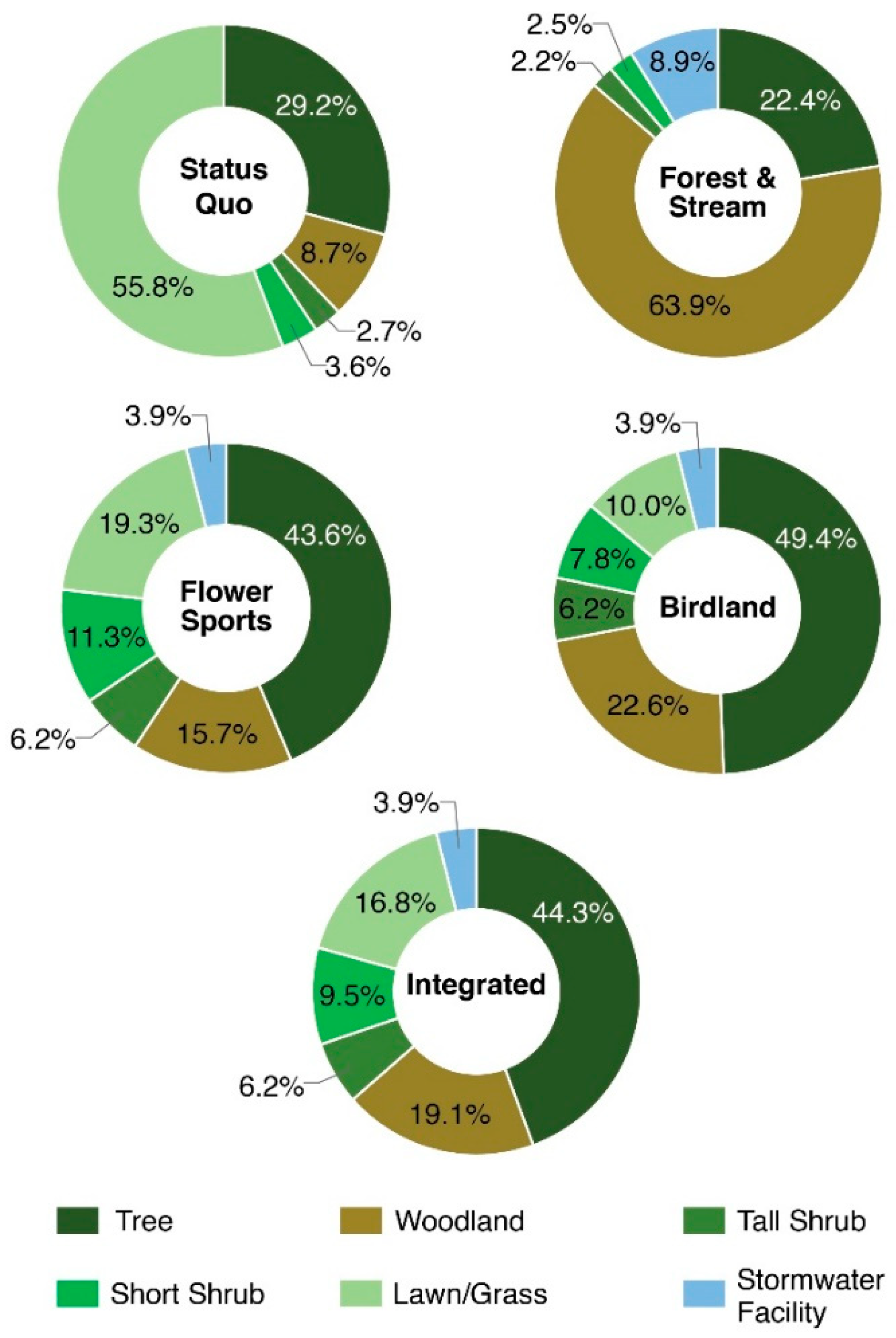
| Priority Ecosystem Services | First Survey | Second Survey c | ||
|---|---|---|---|---|
| Ranking Mean b | Ranking Median b | Priority for Right-of-Way (%) | Priority for Parks (%) | |
| Stormwater Purification | 3.2 | 2.0 | 86.7 | 80.0 |
| Carbon Sequestration | 6.1 | 4.0 | 66.7 | 80.0 |
| Air Purification | 3.9 | 3.0 | 73.3 | 66.7 |
| Native Species | 6.6 | 7.5 | 73.3 | 73.3 |
| Aesthetic/Natural Beauty | 7.7 | 8.0 | 73.3 | 66.7 |
| Flood Reduction | 7.9 | 6.0 | 66.7 | 66.7 |
| Air Temperature Regulation | 5.4 | 4.5 | 73.3 | - d |
| Habitat for Birds/Pollinators | 8.0 | 7.0 | - d | 73.3 |
| Educational Opportunities | N/A | N/A | - d | 66.7 |
| Alternative Planting Regime | Area Converted ha | Air Purification Tonnes yr−1 (% change) | Carbon Storage Tonnes (% change) | Runoff Retention b kL/12 mm storm event (% change) | Stormwater Pollutant Filtration c (%) |
|---|---|---|---|---|---|
| Status Quo a | 0 | 2.0 (0%) | 2860 (0%) | 4720 (0%) | (0%) |
| Forest and Stream | 32.0 | 2.8 (+38.5%) | 7570 (+164.9%) | 4960 (+3.5%) | (80%) |
| Birdland | 26.3 | 2.9 (+44.2%) | 5710 (+99.9%) | 4810 (+1.9%) | (33.2%) |
| Flower Sports | 21.0 | 2.7 (+33.4%) | 4860 (+70.0%) | 4750 (+0.5%) | (33.2%) |
| Integration | 22.4 | 2.7 (+36.7%) | 5160 (+80.5%) | 4770 (+1.0%) | (33.2%) |
Publisher’s Note: MDPI stays neutral with regard to jurisdictional claims in published maps and institutional affiliations. |
© 2020 by the authors. Licensee MDPI, Basel, Switzerland. This article is an open access article distributed under the terms and conditions of the Creative Commons Attribution (CC BY) license (http://creativecommons.org/licenses/by/4.0/).
Share and Cite
Elderbrock, E.; Enright, C.; Lynch, K.A.; Rempel, A.R. A Guide to Public Green Space Planning for Urban Ecosystem Services. Land 2020, 9, 391. https://doi.org/10.3390/land9100391
Elderbrock E, Enright C, Lynch KA, Rempel AR. A Guide to Public Green Space Planning for Urban Ecosystem Services. Land. 2020; 9(10):391. https://doi.org/10.3390/land9100391
Chicago/Turabian StyleElderbrock, Evan, Chris Enright, Kathryn A. Lynch, and Alexandra R. Rempel. 2020. "A Guide to Public Green Space Planning for Urban Ecosystem Services" Land 9, no. 10: 391. https://doi.org/10.3390/land9100391
APA StyleElderbrock, E., Enright, C., Lynch, K. A., & Rempel, A. R. (2020). A Guide to Public Green Space Planning for Urban Ecosystem Services. Land, 9(10), 391. https://doi.org/10.3390/land9100391





